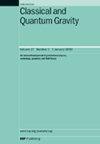Simulated alignment method for suppressing tilt-to-length coupling noise in space gravitational wave telescopes
IF 3.6
3区 物理与天体物理
Q2 ASTRONOMY & ASTROPHYSICS
引用次数: 0
Abstract
Space gravitational wave telescopes are critical in achieving precise interstellar laser interferometry. The coupling coefficient is a key metric for evaluating the ultimate performance of a telescope. However, alignment errors during the assembly phase can degrade the wavefront quality of the telescope, intensify coupling noise, and impair overall performance. Currently, no alignment scheme specifically targets the coupling-noise coefficient of telescopes. To address this, this study proposes a sensitivity matrix model that relates misalignment to the coupling coefficient and establishes clear sampling criteria for coupling noise at the exit pupil of the telescope. The model incorporates second-order correction terms, enabling a more accurate characterisation of the relationship between misalignment and tilt-to-length coupling-noise coefficients. Based on this model, an alignment scheme was developed using the coupling coefficient as the evaluation metric. Owing to the significant differences in the magnitudes of sensitivity among different misalignments and their mutual coupling effects, the predicted alignment parameters often differ substantially from the actual values. To resolve this issue, a misalignment grouping strategy was proposed to reduce prediction errors. Additionally, an iterative algorithm and a sequential adjustment strategy for components were provided to ensure alignment effectiveness. Finally, the feasibility of the proposed method was verified using a typical space gravitational wave telescope model. Experimental results show that the method successfully aligned 500 randomly misaligned samples, with all samples satisfying the requirement of a coupling noise of less than 25 pm μrad−1 after alignment. This method provides new guidance for the alignment of space gravitational wave telescope systems.抑制空间引力波望远镜斜长耦合噪声的模拟对准方法
空间引力波望远镜是实现精确星际激光干涉测量的关键。耦合系数是评价望远镜最终性能的关键指标。然而,装配阶段的对准误差会降低望远镜的波前质量,加剧耦合噪声,影响望远镜的整体性能。目前,还没有针对望远镜耦合噪声系数的对准方案。为了解决这一问题,本研究提出了一个将不对准与耦合系数联系起来的灵敏度矩阵模型,并为望远镜出瞳处的耦合噪声建立了明确的采样准则。该模型包含二阶校正项,能够更准确地描述不对准与倾斜-长度耦合-噪声系数之间的关系。在此基础上,提出了以耦合系数为评价指标的对准方案。由于不同准直误差之间的灵敏度大小及其相互耦合效应的显著差异,预测的准直参数往往与实际值相差很大。为了解决这一问题,提出了一种错位分组策略来降低预测误差。此外,还提出了一种迭代算法和一种顺序调整策略,以保证对齐的有效性。最后,利用典型空间引力波望远镜模型验证了该方法的可行性。实验结果表明,该方法成功对准了500个随机错对准样本,对准后所有样本都满足耦合噪声小于25 pm μrad−1的要求。该方法为空间引力波望远镜系统的对准提供了新的指导。
本文章由计算机程序翻译,如有差异,请以英文原文为准。
求助全文
约1分钟内获得全文
求助全文
来源期刊

Classical and Quantum Gravity
物理-天文与天体物理
CiteScore
7.00
自引率
8.60%
发文量
301
审稿时长
2-4 weeks
期刊介绍:
Classical and Quantum Gravity is an established journal for physicists, mathematicians and cosmologists in the fields of gravitation and the theory of spacetime. The journal is now the acknowledged world leader in classical relativity and all areas of quantum gravity.
 求助内容:
求助内容: 应助结果提醒方式:
应助结果提醒方式:


